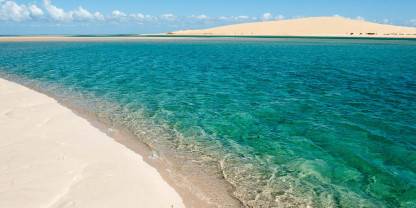Average Expert Rating
Rating Breakdown
Write a User ReviewIdyllic Beaches & Recovering Parks
Mozambique has some of the most beautiful beaches in Africa. Yet, its 2,500km coastline is remarkably unspoiled and undeveloped. Most tourism is confined to its islands: Bazaruto in the south and the Quirimbas in the north. Both archipelagos are renowned for their luxury lodges and fantastic diving opportunities.
Compared to many other countries in the region, Mozambique doesn’t have a lot to offer in terms of safaris, but there are a few gems. Maputo National Park offers a unique ‘beach and bush’ experience; the marine-wildlife viewing is out of this world, but the main reason for the reserve’s creation was to protect southern Africa’s last-remaining coastal elephant population. Gorongosa National Park is perhaps Mozambique’s hottest safari destination. Once known as the Serengeti of southern Africa, it is on a strong path to being worthy of this nickname once again. As the park has received higher protection, animals are coming back and the growing lion population
The Great Limpopo Transfrontier Conservation Area (GLTFCA) is currently undergoing a lot of development as well. This 100,000km2 Peace Park protects Kruger in South Africa, Gonarezhou in Zimbabwe and Limpopo, Banhine and Zinave National Parks in Mozambique. Zinave, in particular, is rapidly becoming a worthwhile safari destination. In recent years, thousands of animals have been translocated here and subsequently lions have turned up on their own account. Its proximity to Vilanculos and the popular Bazaruto Archipelago makes this exciting new Big Five destination a great addition to a Mozambique beach holiday.
Compared to many other countries in the region, Mozambique doesn’t have a lot to offer in terms of safaris, but there are a few gems. Maputo National Park offers a unique ‘beach and bush’ experience; the marine-wildlife viewing is out of this world, but the main reason for the reserve’s creation was to protect southern Africa’s last-remaining coastal elephant population. Gorongosa National Park is perhaps Mozambique’s hottest safari destination. Once known as the Serengeti of southern Africa, it is on a strong path to being worthy of this nickname once again. As the park has received higher protection, animals are coming back and the growing lion population
Read more
is a good indication of a recovering ecosystem.The Great Limpopo Transfrontier Conservation Area (GLTFCA) is currently undergoing a lot of development as well. This 100,000km2 Peace Park protects Kruger in South Africa, Gonarezhou in Zimbabwe and Limpopo, Banhine and Zinave National Parks in Mozambique. Zinave, in particular, is rapidly becoming a worthwhile safari destination. In recent years, thousands of animals have been translocated here and subsequently lions have turned up on their own account. Its proximity to Vilanculos and the popular Bazaruto Archipelago makes this exciting new Big Five destination a great addition to a Mozambique beach holiday.
Beaches, History … and a Bit of Safari
Mozambique is first, second and third a beach nirvana, fourth an area of historic interest, and maybe fifth or sixth a safari destination. Running all the way north from Ponta do Ouro (on the border with South Africa) to the mighty Ruvuma River (bordering Tanzania), the country’s 2,500km of Indian Ocean frontage is studded with palm-lined tropical beaches as attractive to sunbathers and swimmers as they are to snorkellers, divers and game fishers. The country also boasts a few compelling old ports, most notably Ilha do Moçambique, which served as the Portuguese capital from 1530 to 1898, and is one of the most atmospheric historic towns anywhere in southern Africa. By contrast, the country’s main potential safari destinations either suffered heavy losses to poaching during the years of civil war, or remain largely undeveloped. That said, the refurbished Gorongosa National Park is well worth a visit, and has the long-term potential to become as important an attraction as it was in the

